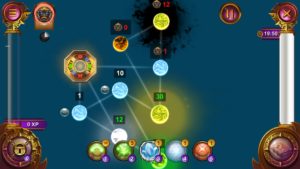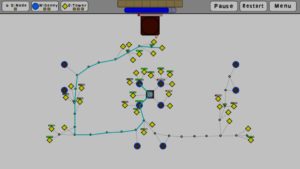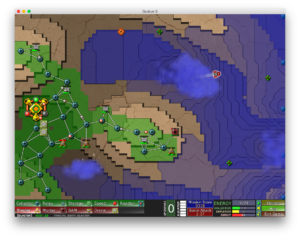Fluid Armies
OK, obviously I was going to take a little break from DROD when the Steam Summer Sale came up. Like last time, I’d like to take a brief look at a few of the things I bought for cheap.
As usual, I started by just getting the cheapest things on my wishlist — and from the results, I think I must have really been nostalgic for xbattle recently. This is a game I remember playing back in college, at a time when online multiplayer games were only easily played at an academic computing lab. Apparently there are multiple games called “xbattle”, so I should specify that the one I mean was a primitive RTS, named for its use of the X11 windowing system, and notable mainly for its high degree of abstraction. The battlefield was a grid of squares (or hexes, but we mainly played it in square mode), and any troops were represented by a colored square within that, the number of troops indicated by the size. Certain points on the map produced more troops at a steady rate for whoever captured them. You moved troops around by pointing squares at adjacent squares, causing the color to slowly drain from one to the other over time at a rate governed by their size difference. Consequently, the game was mainly about supply lines, each player trying to keep troops flowing efficiently to the front and interfere with the opponent doing the same, to keep them from pumping in reinforcements as fast as you.
As my choice of words here indicates, it feels a lot more like a game about fluids than a game about armies. Supply lines visibly have a pulse — we sometimes called it “the pulsing squares game” back in the day. Directing troop movement is a matter of opening and closing valves.
 Of the games I’m recognizing as xbattle-like, Five Elements, a casual game with slick production values, is the closest and clearest. It uses a semi-randomized freeform graph of nodes instead of a grid, but it the essential mechanics are the same: opening spigots from node to node, pouring substances to fight. If anything, it’s a purer expression of the idea than xbattle is, because it makes no pretence that the fluids are armies. The battles are called “meditations”, and are supposed to be taking place inside the player character’s head. The enemies are aspects of his mind that he’s trying to subdue, such as Laziness and Fear and Anger, with appropriate special abilities. Instead of troops, you’re channeling abstract essences drawn from traditional Chinese alchemy, the five elements of the title. These are bound up in an extended rock-paper-scissors cycle of vulnerabilities and resistances: water beats fire, obviously, but also water “devours” metal, meaning that attacking an enemy’s water node with your metal node will strengthen it. Every pair of elements has one of these relationships — either one destroys the other or one devours the other. I find this difficult to keep track of, in part because the visuals don’t suggest the elements very clearly. The UI provides some help here, displaying an icon indicating what you’re in for before you open a spigot, but it’s still hard to make long-range plans under time pressure when you’re querying every possibility this way. Perhaps for this reason, the levels tend to be small. There’s a lot of them, though. This is clearly meant to be played in little bits over a long period of time, and I don’t know if I’ll want to keep up with it to the end.
Of the games I’m recognizing as xbattle-like, Five Elements, a casual game with slick production values, is the closest and clearest. It uses a semi-randomized freeform graph of nodes instead of a grid, but it the essential mechanics are the same: opening spigots from node to node, pouring substances to fight. If anything, it’s a purer expression of the idea than xbattle is, because it makes no pretence that the fluids are armies. The battles are called “meditations”, and are supposed to be taking place inside the player character’s head. The enemies are aspects of his mind that he’s trying to subdue, such as Laziness and Fear and Anger, with appropriate special abilities. Instead of troops, you’re channeling abstract essences drawn from traditional Chinese alchemy, the five elements of the title. These are bound up in an extended rock-paper-scissors cycle of vulnerabilities and resistances: water beats fire, obviously, but also water “devours” metal, meaning that attacking an enemy’s water node with your metal node will strengthen it. Every pair of elements has one of these relationships — either one destroys the other or one devours the other. I find this difficult to keep track of, in part because the visuals don’t suggest the elements very clearly. The UI provides some help here, displaying an icon indicating what you’re in for before you open a spigot, but it’s still hard to make long-range plans under time pressure when you’re querying every possibility this way. Perhaps for this reason, the levels tend to be small. There’s a lot of them, though. This is clearly meant to be played in little bits over a long period of time, and I don’t know if I’ll want to keep up with it to the end.
 Energia, a shortish lo-fi indie piece, also uses a freeform graph, because the graph is one that you build yourself, by placing nodes and blasters and linking them up to pre-existing power sources. It’s basically a tower defense, and it doesn’t much feel like you’re piping fluids around — it goes for more of an electricity feel, with energy leaping through nodes of the graph instantly. But I count it as xbattle-like for two reasons. First, it’s largely about maintaining those supply lines. Attackers can come in from any direction and sever your graph at any point that isn’t adequately defended. Secondly, it’s extremely abstract. This is a not really a representation of a battle, and the game takes advantage of the fact when serving up variations. For example, one level is based on the idea that the battlefield is constantly scrolling to the right. Your base is fixed in place on the right side, the enemy’s base is on the left, but everything else, including anything you build, moves past you and then is lost. Playing this level feels like trying to walk up a descending escalator. Another level puts all the power sources on a pair of large rotating circles. Basically, the game’s greatest strength is the variety it can get away with because it’s nonrepresentational.
Energia, a shortish lo-fi indie piece, also uses a freeform graph, because the graph is one that you build yourself, by placing nodes and blasters and linking them up to pre-existing power sources. It’s basically a tower defense, and it doesn’t much feel like you’re piping fluids around — it goes for more of an electricity feel, with energy leaping through nodes of the graph instantly. But I count it as xbattle-like for two reasons. First, it’s largely about maintaining those supply lines. Attackers can come in from any direction and sever your graph at any point that isn’t adequately defended. Secondly, it’s extremely abstract. This is a not really a representation of a battle, and the game takes advantage of the fact when serving up variations. For example, one level is based on the idea that the battlefield is constantly scrolling to the right. Your base is fixed in place on the right side, the enemy’s base is on the left, but everything else, including anything you build, moves past you and then is lost. Playing this level feels like trying to walk up a descending escalator. Another level puts all the power sources on a pair of large rotating circles. Basically, the game’s greatest strength is the variety it can get away with because it’s nonrepresentational.
 The highly satisfying Creeper World is mechanically similar: it’s basically a tower defense in which you build a network of nodes that rely on their connection to your main base to receive power. “Energy packets”, for construction and ammo, visibly flow along the lines of the graph, giving it a little bit of that fluid-and-pipes feel. The part that really feels fluid, though, is the enemy, called “creeper”. Creeper is quite visibly a liquid. It’s like you’re fighting the ocean. It’s viscous enough that it takes a while to level out and can even pile up around its outflow pipe, but it quite visibly flows like a liquid, ripples when you drop a mortar shell into it, fills up holes in the ground in preference to advancing toward your base — elevation is key in so many ways. (A note in the game says that it’s actually modeled on heat flow, but physics has a way of repeating itself in different contexts.) As a result, you get to play offense in the supply-line game. Cut off all the inlets into a lakebed, and it’ll dry up, at which point you can claim it for yourself. That’s one of the more satisfying things in the game: painstakingly cutting through a crucial stretch of creeper and seeing sudden and dramatic effects.
The highly satisfying Creeper World is mechanically similar: it’s basically a tower defense in which you build a network of nodes that rely on their connection to your main base to receive power. “Energy packets”, for construction and ammo, visibly flow along the lines of the graph, giving it a little bit of that fluid-and-pipes feel. The part that really feels fluid, though, is the enemy, called “creeper”. Creeper is quite visibly a liquid. It’s like you’re fighting the ocean. It’s viscous enough that it takes a while to level out and can even pile up around its outflow pipe, but it quite visibly flows like a liquid, ripples when you drop a mortar shell into it, fills up holes in the ground in preference to advancing toward your base — elevation is key in so many ways. (A note in the game says that it’s actually modeled on heat flow, but physics has a way of repeating itself in different contexts.) As a result, you get to play offense in the supply-line game. Cut off all the inlets into a lakebed, and it’ll dry up, at which point you can claim it for yourself. That’s one of the more satisfying things in the game: painstakingly cutting through a crucial stretch of creeper and seeing sudden and dramatic effects.
 Comments(0)
Comments(0)